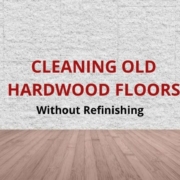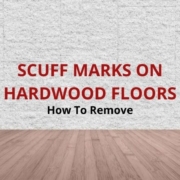How To Disinfect A Hardwood Floor
Unless you’ve just returned from spending the past year and a half on another planet, you don’t need this or any other article to explain or emphasize the importance of taking precautions against the transmission of disease. The COVID-19 pandemic has taught us a lot.
The past forty years have given rise to infectious diseases that had previously been unheard of. But COVID-19 is the virus that changed the way the whole world thinks about disinfection. It changed our entire approach. For some of us, COVID-19 even became a partisan issue.
In this article, we’ll discuss combating the COVID-19 virus and other pathogens on a wood floor. The article will also answer some frequently asked questions about how to do this, and what to expect.
The following assumes that your hardwood floors are finished with a urethane type of sealant. As always, follow the manufacturer’s recommendations and directions.
Is There A Way To Disinfect Hardwood Floors Without Using a Bucket and Without Rinsing?
We’re not terribly high on the mop and bucket idea. This is mostly because we understand how damaging it can be to drench hardwood or expose it to more moisture than absolutely necessary. Mopping calls for this as part of the process and rinsing calls for the process to be repeated.
There is indeed an easier way to disinfect hardwood floors.
In fact, there are a few easier ways. Let’s discuss what you should know.
Sanitizing vs Disinfecting A Wood Floor: What’s the Difference?
According to The Centers For Disease Control and Prevention (CDC):
- Cleaning is a process where soap and water is used to remove germs, dirt and impurities. By reducing the number of germs, cleaning reduces the risk of infection.
- Disinfecting uses chemicals to kill germs. Disinfecting doesn’t necessarily target dirt and impurities. By killing germs, disinfection reduces the risk of infection.
- Sanitizing lowers the number of germs on surfaces or objects to a safe level, as judged by public health standards or requirements. This process works by either cleaning OR disinfecting to lower the risk of spreading infection.
With these facts in mind, cleaning should precede disinfecting.
According to the U.S. Environmental Protection Agency:
EPA expects all products on List N (EPA’s list of approved disinfectants) to kill the coronavirus SARS-CoV-2 (COVID-19) when used according to the label directions.
This means that no matter what organisms it kills, in order for a product to call itself a disinfectant, organisms that are COVID-19 pathogens must be included in the scope.
Using an Antibacterial Wood Floor Cleaner to Disinfect Hardwood Floors

Antibacterials focus on reducing the number of bacteria whereas the focus of disinfectants is broader. Disinfectants (antimicrobials) reduce the number of bacteria, viruses, fungi, and certain types of insect vermin. All products labeled “disinfectant” kill COVID-19 microbes.
While many products reduce the number of many types of microbes, and meet the standards for categorization as a disinfectant by the EPA, some manufacturers choose to label their products as antibacterials instead. We can only assume that such decisions are driven by marketing strategies. But depending on the active ingredients, products labeled “antibacterial” can be used to disinfect. Product labels are key.
Although they seem to be few and far in between, there are a few disinfecting floor cleaners available on the market. Rejuvenate® makes an antibacterial wood floor cleaning product that’s also approved as a disinfectant by the EPA.
Rejuvenate® antibacterial wood floor cleaner still needs to be rinsed. But for bargain hunters and for those who prefer not to work any harder or longer than necessary, the term, “two-fer” (two for one/two in one) applies. For those who consider themselves to be devotees of both, you’ve hit paydirt.
Should You Use Bleach To Disinfect Hardwood Floors?
To be clear, bleach is a disinfectant. Clorox is the most popular brand of bleach.
Yet, Clorox manufactures disinfecting wet mopping cloths that do not contain bleach. Clorox also recommends its non-bleach wood floor cleaning product over bleach for cleaning wood floors. These two facts should tell you everything you need to know about using bleach to disinfect hardwood floors.
Undiluted bleach should never be applied to a wood floor unless removing the finish and/or the color is the goal. Applying a dilute form offers no relief from rinsing. So, let’s cross bleach off the list..
Should You Use A Steam Mop To Disinfect Hardwood Floors?

Try thinking of it this way; If it isn’t safe to transfer a product’s use as directed to the palm of your hand for a full five seconds, it probably isn’t a good idea to use on hardwood floors. Does that seem extreme? Then, check out your wood floor manufacturers’ recommendations. If the manufacturer recommends the use of a steam mop to disinfect your hardwood floors, raise your hand.
See what I mean?
Of course, the reason for not applying steam to hardwood floors might not be quite the same as the reason for not applying it to your skin. But by sticking with this rule of thumb, you’ll be giving your wood floor the gentle treatment it requires.
As a cleaning solution, antibacterial, antiviral, antimicrobial, boiled water, and steam are equally effective options. But applying a high-temperature solution to a wood floor will do more harm than good.
For floors installed with glue (floor adhesive), applying extremely hot water or steam is likely to cause the glue to lose its adhesive properties,
For wood floors installed with nails, a boiling hot solution would cause both the nails as well as the floorboards to expand considerably. The nails are more apt to rust and stain your hardwood floors before ultimately causing the floorboards to become less securely fastened.
This isn’t to say that steam can be applied to a floating wood floor without consequence either.
As it is, a hardwood floor’s exposure to moisture should be limited. Where wood floors are warped or have dark stains on them, moisture is the culprit. To expose a wood floor to moist heat or to do so on a routine basis doesn’t align with the effort that should be undertaken to limit the floor’s contact with moisture.
How to Disinfect Hardwood Floors without Damaging Them
Despite the best intentions, and sometimes, because of them, wood floors can be damaged. But this doesn’t need to happen. As long as exposure to water, harsh chemicals, and extreme measures is limited, the risk of damage is minimal. Hence, the rule of thumb as discussed earlier.
How to Disinfect Hardwood Floors Naturally
The terms “natural”, “naturally”, and “nature” conjure ethereal images of flowered meadows where the sun shines and breezes blow gently.
They might not be as pleasant as the scenario above, but chemicals, chemical bi-products, and chemical reactions are also natural.
The active ingredients usually contained in an EPA registered disinfectant are natural in that they are environmentally safe.
Of course, it would be nice to find a disinfectant that’s safe to use around children and pets as well. An inexpensive supermarket or drugstore product that doesn’t need to be rinsed would also be helpful.
There’s only one product that ticks all the boxes – hydrogen peroxide. Where the previously discussed “two fer” is analogous to paydirt, hydrogen peroxide is the motherlode.
Hydrogen peroxide is usually sold in concentrations of 3% or 6%. You can use the 3% concentration to disinfect your hardwood floor without first diluting it.
Hydrogen peroxide is sold in dark brown colored or opaque containers to protect it from light. Prolonged exposure to light and temperatures above 80F can cause the solution to become inert. It’s best used within a couple of months of purchase as it will expire in six months and will lose its effectiveness.
Use Hydrogen Peroxide To Disinfect Hardwood Floors
Transfer hydrogen peroxide from its original container to a clean spray bottle. Be sure to set the original aside so that you can transfer any remaining peroxide back into it when you’re done disinfecting your floors.
If you have a wet mop with a built-in cleaning solution container, you can bypass the spray bottle and pour hydrogen peroxide directly into the container instead.
You’ll also need several clean microfiber sleeves for your flat mop or untreated cleaning cloths for your Swiffer-style mop.
Working in sections:
- Spray the hydrogen peroxide directly onto your hardwood floor.
- Allow the floor to remain wet for 30-40 seconds.
- Use a dry, microfiber mop head to wipe the peroxide from the floor.
- Continue wiping the floor until it’s completely dry. Doing this will remove any haze that might remain. If the mop head becomes saturated, replace it with a clean, dry one.
Many people report that using hydrogen peroxide to clean and disinfect their hardwood floors also left them looking almost new. A pleasant side-effect.
How To Disinfect Hardwood Floors Without Lifting a Finger
Although you’ll still need to vacuum your wood floor to remove dust and other particles, the number of pathogens and insect vermin are very effectively reduced with the application of ultraviolet light. Many ultraviolet light fixtures designed with disinfection and elimination of insect vermin in mind are available for household use at reasonable prices.
Of course, because ultraviolet light isn’t the type of disinfecting medium evaluated by the EPA, it is neither approved nor rejected for categorization as a disinfectant. But ultraviolet lamps are frequently used in patient facilities where pathogens can be especially problematic if not immediately eliminated.
How To Prevent Pathogens From Contaminating Your Hardwood Floors
For the vast majority of the world population, it is customary to remove shoes before or immediately upon entering a home. Why this isn’t customary in the U.S. is not certain. Given the enormity of our science and technology community and all that we know about the spread of disease, there’s no excuse for not adopting this custom.
Shoes are dirty and should not be worn inside the home any more than they should be worn to bed. When shoes are worn outside, they pick up organisms that are present on sidewalks, streets, and gutters.
Naturally, these organisms will be transported from the street to locations inside the home if the shoes that transport them aren’t first removed. Removal of shoes also keeps dirt, mud, and sand from being tracked in and scratching your hardwood floors.
Ultraviolet light units are available in the form of hand-held wands. If shoes must be worn inside, passing a wand over the uppers and soles couldn’t hurt.
Table of Contents






